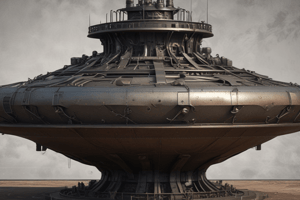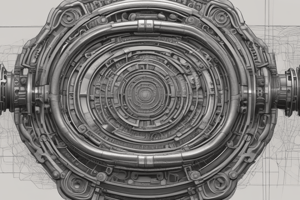Podcast
Questions and Answers
What is the main characteristic of grey cast iron?
What is the main characteristic of grey cast iron?
- It is primarily used for high-temperature applications.
- It is extremely hard and cannot be machined.
- It has a high carbon content that makes it brittle. (correct)
- It is resistant to abrasion and wear.
What is the primary purpose of the Open Hearth Furnace in steel production?
What is the primary purpose of the Open Hearth Furnace in steel production?
- To control the temperature during steel casting
- To add alloying elements to steel
- To determine the correct carbon content in molten iron (correct)
- To maximize the production speed of steel
Which statement about white cast iron is true?
Which statement about white cast iron is true?
- It is designed for surfaces requiring abrasion resistance. (correct)
- It can be easily machined without grinding.
- It cools rapidly in standard conditions to produce a soft material.
- It has a lower carbon content than grey cast iron.
What is pig iron primarily composed of?
What is pig iron primarily composed of?
Which material is primarily used to withstand the high temperatures in a crucible furnace?
Which material is primarily used to withstand the high temperatures in a crucible furnace?
What is a key characteristic of the electric furnace compared to other types of furnaces?
What is a key characteristic of the electric furnace compared to other types of furnaces?
Which process leads to the formation of hard cast iron?
Which process leads to the formation of hard cast iron?
How does adding carbon up to approximately 1% affect iron?
How does adding carbon up to approximately 1% affect iron?
In the Basic Oxygen Process, what is primarily blown through the molten bath?
In the Basic Oxygen Process, what is primarily blown through the molten bath?
Which steel-making process has been mostly replaced by the electric furnace?
Which steel-making process has been mostly replaced by the electric furnace?
What is a common application for grey cast iron?
What is a common application for grey cast iron?
What additional materials may be included in the crucible when making alloy steel?
What additional materials may be included in the crucible when making alloy steel?
Which of the following best describes the cooling method for producing grey cast iron?
Which of the following best describes the cooling method for producing grey cast iron?
What is a fundamental characteristic of an alloy?
What is a fundamental characteristic of an alloy?
What kind of structures does the electric arc furnace control best during steel production?
What kind of structures does the electric arc furnace control best during steel production?
Which material acts as a fluxing agent in the Basic Oxygen Process?
Which material acts as a fluxing agent in the Basic Oxygen Process?
What is the main purpose of tempering in steel treatment?
What is the main purpose of tempering in steel treatment?
Which heat treatment process involves hardening a thin surface layer on steel?
Which heat treatment process involves hardening a thin surface layer on steel?
What does the heat treatment process aim to achieve besides making metals stronger?
What does the heat treatment process aim to achieve besides making metals stronger?
At what temperature range is steel typically tempered?
At what temperature range is steel typically tempered?
Which method can be used to cool steel after tempering?
Which method can be used to cool steel after tempering?
Why can't all metals and alloys be heat treated?
Why can't all metals and alloys be heat treated?
Which heat treatment process is specifically aimed at improving the machinability of hardened steel?
Which heat treatment process is specifically aimed at improving the machinability of hardened steel?
Which of the following metals typically responds well to heat treatment?
Which of the following metals typically responds well to heat treatment?
What is the primary purpose of the annealing process?
What is the primary purpose of the annealing process?
During full annealing, at what temperature should the steel be heated?
During full annealing, at what temperature should the steel be heated?
What is the cooling process in normalizing?
What is the cooling process in normalizing?
What effect does hardening have on the metal?
What effect does hardening have on the metal?
Which method is NOT commonly associated with case hardening?
Which method is NOT commonly associated with case hardening?
What is the main benefit of case hardening?
What is the main benefit of case hardening?
What is the purpose of soaking the steel during the annealing process?
What is the purpose of soaking the steel during the annealing process?
Which quenching medium results in the least amount of heat retention?
Which quenching medium results in the least amount of heat retention?
Which of the following elements is mentioned as being allotropic?
Which of the following elements is mentioned as being allotropic?
What is the primary purpose of hard anodising coating?
What is the primary purpose of hard anodising coating?
Which type of anodising is known for its dull yellow-green appearance when sealed?
Which type of anodising is known for its dull yellow-green appearance when sealed?
What is a characteristic feature of Type 1 cadmium plating?
What is a characteristic feature of Type 1 cadmium plating?
What distinguishes Type 2 cadmium plating from Type 1?
What distinguishes Type 2 cadmium plating from Type 1?
Which application is a known use for hard anodising coating?
Which application is a known use for hard anodising coating?
What is a key feature of Type 3 cadmium plating?
What is a key feature of Type 3 cadmium plating?
Which characteristic describes aluminium in relation to allotropism?
Which characteristic describes aluminium in relation to allotropism?
Study Notes
Grey Cast Iron
- Grey cast iron is produced when liquid cast iron cools slowly
- It contains about 3.5% carbon, which makes it brittle
- Grey cast iron fractures easily from sharp blows
- It has a grey crystalline colour when fractured
- Grey cast iron is used for large pipes, steam radiators, water hydrants, and machine frames
White Cast Iron
- White cast iron is produced by rapidly cooling or chilling liquid iron
- It has a carbon content of 2% to 3.5%
- White cast iron is extremely hard and cannot be machined except by grinding
- It is used for castings needing abrasion and wear resistance
Pig Iron
- Pig iron is formed by pouring melted iron from the blast furnace into sand molds
- The molds are parallel trenches with a connecting channel, forming "pigs" connected to a long bar called the "Sow"
- Pig iron is about 93% pure iron, 3-5% carbon, and smaller amounts of silicon, phosphorus, sulfur, and manganese
Carbon Steel
- Adding 1% or less of carbon to iron produces carbon steel, which is vastly superior to plain iron
- An alloy is a base metal (like iron) with small amounts of other metals added to improve its properties
- Carbon steel is made by heating pig iron, wrought iron, and scrap metal in an open-hearth furnace
- The furnace uses hot air and gas to keep the iron liquid and carbon levels are adjusted before pouring the metal into ingots
Crucible Steel
- Crucible steel is high-carbon steel or alloy steel made by melting wrought iron and scrap steel in a crucible
- Carbon or other alloying elements are added to the crucible and melted with the iron
- The steel is then poured into ingot molds
- The electric arc furnace has largely replaced the crucible furnace for making high-quality steel
Electric Furnace Steel
- The electric furnace is used when precise temperature control and alloying element addition is crucial
- It achieves higher temperatures than other steel-making furnaces
- High-carbon steel, special alloy steel, and high-speed steel are produced in electric furnaces
- Electric furnaces allow for control of the steel's grain structure
Basic Oxygen Process
- The Basic Oxygen Process uses oxygen to quickly refine iron ore, steel scrap, and molten iron
- Oxygen is blown down from the top through a lance into the molten metal bath
- Burnt lime and other fluxing agents are added during the process to refine the steel
Annealing
- Annealing is a softening process that relieves internal stress in steel
- It brings the steel into its softest possible condition when cold
- Annealing refines the steel's grain structure
- Full annealing involves heating the steel above its upper critical temperature, soaking it, and cooling it slowly
- Process annealing is similar but involves lower temperatures
Normalizing
- Normalizing refines the steel's grain structure and relieves stress
- It is used before other heat treatments
- Normalizing involves heating the steel above its upper critical temperature, soaking it, and cooling it in still air
Hardening
- Hardening produces a fine grain structure and high hardness
- It involves heating the steel above its critical temperature, soaking it, and rapidly quenching it in a medium like brine, water, oil, or air
Case Hardening
- Case hardening involves producing a hard, wear-resistant surface while keeping the core tough
- Common methods of Case Hardening include carburizing, cyaniding and nitriding
- Carburizing involves soaking the metal in a carbonaceous material
- Cyaniding involves immersing the steel in a molten bath of cyanide salts
- Nitriding involves heating the steel in anhydrous ammonia to produce a hard surface
Tempering
- Tempering, also called drawing, relieves internal strain in hardened steel, increasing its toughness
- It involves heat treating hardened steel below its lower critical temperature, soaking it, and cooling it in air or a quenching medium
- Tempering prevents cracking or fracturing under stress
Uses of Different Heat Treated Materials
- Ferrous metals (iron and steel) are commonly heat treated
- Some aluminum alloys can be heat treated while others require cold working for hardening
- Heat treating high-temperature nickel-based alloys is done in some cases depending on composition
- The temperatures and process of heat treatment vary among different metals
Heat Treatment
- Heat treatment hardens or strengthens metals
- It also makes metals softer and more ductile
- Heat treatment types include hardening, tempering, annealing, normalizing, and case hardening
Anodic Treatment
- Anodic treatment is used to provide corrosion resistance and other properties to aluminum parts
- The three types of anodic treatment specified by MIL-A-8625R are Chromic Anodise Coating, Sulphuric Anodise Coating, and Hard Anodising Coating
- Chromic Anodise Coating is a dark-grey coating used for sealing and corrosion resistance
- Sulphuric Anodise Coating is best for dyeing, has a dull yellow-green appearance, and is used for sealing
- Hard Anodising Coating provides electrical insulation and abrasion resistance to parts like hydraulic cylinders and actuator cams
Cadmium Plating
- Cadmium plating is a non-porous, electrolytically deposited layer that resists corrosion on steel
- Type 1 is pure, silver-coloured cadmium plating
- Type 2 is cadmium plating followed by a chrome treatment for improved corrosion resistance
- Type 3 is cadmium plating followed by a phosphate treatment, primarily for paint base
Studying That Suits You
Use AI to generate personalized quizzes and flashcards to suit your learning preferences.
Related Documents
Description
This quiz explores the characteristics and applications of various types of cast iron, including grey, white, and pig iron, as well as carbon steel. You'll learn about their chemical compositions, production methods, and uses in industries. Test your knowledge on these essential materials in metallurgy.





